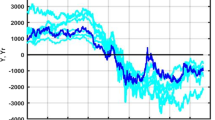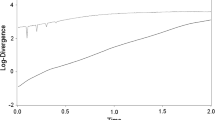Abstract
In a nonlinear, chaotic dynamical system, there are typically regions in which an infinitesimal error grows and regions in which it decays. If the observer does not know the evolution law, recourse is taken to non-dynamical methods, which use the past values of the observables to fit an approximate evolution law. This fitting can be local, based on past values in the neighborhood of the present value as in the case of Farmer–Sidorowich (FS) technique, or it can be global, based on all past values, as in the case of Artificial Neural Networks (ANN). Short-term predictions are then made using the approximate local or global mapping so obtained. In this study, the dependence of statistical prediction errors on dynamical error growth rates is explored using the Lorenz-63 model. The regions of dynamical error growth and error decay are identified by the bred vector growth rates or by the eigenvalues of the symmetric Jacobian matrix. The prediction errors by the FS and ANN techniques in these two regions are compared. It is found that the prediction errors by statistical methods do not depend on the dynamical error growth rate. This suggests that errors using statistical methods are independent of the dynamical situation and the statistical methods may be potentially advantageous over dynamical methods in regions of low dynamical predictability.







Similar content being viewed by others
References
Aleksander I, Morton H (1955) An introduction to neural computing. Chapman and Hall, London
Anderson J, Dool H, Barnston A, Chen W, Stern W, Ploshay J (1999) Present-day capabilities of numerical and statistical models for atmospheric extratropical seasonal simulation and prediction. B Am Meteorol Soc 80:1349–1361
Bishop CM (1995) Neural networks for pattern recognition. Oxford University Press, Oxford
Cai M, Kalnay E, Toth Z (2003) Bred vectors of the Zebiak–Cane model and their potential application to ENSO predictions. J Clim 16:40–56
Corti S, Molteni F, Palmer TN (1999) Signature of recent climate change in frequencies of natural atmospheric circulation regimes. Nature 398:799–802
Cybenko G (1989) Approximation by superposition of a sigmoidal function. Math Control Signals Syst 2:303–314
Dwivedi S, Mittal AK (2007) Forecasting the duration of active and break spells in intrinsic mode functions of Indian monsoon intraseasonal oscillations. Geophys Res Lett 34:L16827. doi:10.1029/2007GL030540
Dwivedi S, Mittal AK, Goswami BN (2006) An empirical rule for extended range prediction of duration of Indian summer monsoon breaks. Geophys Res Lett 33:L18801. doi:10.1029/2006GL027035
Dwivedi S, Mittal AK, Pandey AC (2007) Effect of averaging timescale on a forced Lorenz model. Atmos Ocean 45:71–79
Evans E, Bhatti N, Kinney J, Pann L, Peña M, Yang S-C, Kalnay E, Hansen J (2004) RISE undergraduates find that regime changes in Lorenz’s model are predictable. Bull Amer Meteor Soc 85:520–524
Farmer JD, Sidorowich JJ (1987) Predicting chaotic time series. Phys Rev Lett 59:845–848
Goddard L, Mason SJ, Zebiak SE, Ropelewski CF, Basher R, Cane MA (2001) Current approaches to seasonal-to-interannual climate predictions. Int J Climatol 21:1111–1152
Harris DL (1962) The equivalence between certain statistical prediction methods and linearized dynamical methods. Mon Weather Rev 90:331–340
Hastenrath S (1995) Recent advances in tropical climate prediction. J Clim 8:1519–1532
Haykin S (2002) Neural networks. Pearson Education, New Delhi
Hsieh WW, Tang B (1998) Applying neural network models to prediction and data analysis in meteorology and oceanography. B Am Meteorol Soc 79:1855–1870
Kumar A, Wang W, Hoerling MP, Leetma A, Ji M (2001) The sustained North American warming of 1997 and 1998. J Clim 14:345–353
Landman WA, Mason SJ, Tyson PD, Tennant WJ (2001) Retro-active skill of multi-tiered forecasts of summer rainfall over southern Africa. Int J Climatol 21:1–19
Lapeyre G (2002) Characterization of finite-time Lyapunov exponents and vectors in two dimensional turbulence. Chaos 12:697–698
Lee JM, Kaisare NS, Lee JH (2006) Choice of approximator and design of penalty function for an approximate dynamic programming based control approach. J Process Contr 16:135–156
Lorenz EN (1963) Deterministic non-periodic flows. J Atmos Sci 20:130–141
Masters T (1993) Practical neural network recipes in C++. Academic Press, San Diego, CA
Mehta M, Mittal AK, Dwivedi S (2003) The double-cusp map for the forced Lorenz system. Int J Bifur Chaos 13:3029–3035
Mittal AK, Dwivedi S, Pandey AC (2003) A study of the forced Lorenz model of relevance to monsoon predictability. Indian J Radio Space Phys 32:209–216
Mittal AK, Dwivedi S, Pandey AC (2005) Bifurcation analysis of a paradigmatic model of monsoon prediction. Nonlinear Proc Geoph 12:707–715
Mittal AK, Dwivedi S, Yadav RS (2007) Probability distribution for the number of cycles between successive regime transitions for the Lorenz model. Physica D 233:14–20
Monahan AH (2000) Nonlinear principal component analysis by neural networks: theory and application to the Lorenz system. J Clim 13:821–835
Murphy J (1999) An evaluation of statistical and dynamical techniques for downscaling local climate. J Clim 12:2256–2284
O’Reilly JX, Jbabdi S, Rushworth MFS, Behrens TEJ (2013) Brain systems for probabilistic and dynamic prediction: computational specificity and integration. PLoS Biol 11:1–14
Palmer TN (1993) Extended-range atmospheric prediction and the Lorenz model. B Am Meteorol Soc 74:49–66
Palmer TN (1994) Chaos and predictability in forecasting the monsoons. Proc Ind Natl Sci Acad 60A:57–66
Palmer TN (1998) A nonlinear dynamical perspective on climate prediction. J Clim 12:575–591
Pasini A (2008) External forcings and predictability in Lorenz model: an analysis via neural network modeling. Il Nuovo Cimento 31C(357):370
Pasini A, Pelino V (2005) Can we estimate atmospheric predictability by performance of neural network forecasting? The toy case studies of unforced and forced Lorenz models. In: CIMSA 2005—IEEE International conference on computational intelligence for measurement systems and applications, Giardini Naxes, pp 69–74
Rich E, Knight K (1991) Artificial Intelligence. McGraw-Hill, New York
Salmun H, Molod A, Wisniewska K, Buonaiuto FS (2011) Statistical prediction of the storm surge associated with cool-weather storms at the Battery, New York. J Appl Meteorol Climatol 50:273–282
Toth Z, Kalnay E (1993) Ensemble forecasting at NMC: the generation of perturbations. B Am Meteorol Soc 74:2317–2330
Toth Z, Kalnay E (1997) Ensemble forecasting at NCEP and the breeding method. Mon Weather Rev 125:3297–3319
Wilks S (1995) Statistical methods in the atmospheric sciences. Academic Press, San Diego
Yadav RS, Dwivedi S, Mittal AK (2005) Prediction rules for regime changes and length in new regime for the Lorenz’s model. J Atmos Sci 62:2316–2321
Zeng N, Yoon J-H, Vintzileos A, Collatz GJ, Kalnay E, Mariotti A, Kumar A, Busalacchi A, Lord S (2008) Dynamical prediction of terrestrial ecosystems and the global carbon cycle: a 25-year hindcast experiment. Glob Biogeochem Cycles 22:GB4015. doi:10.1029/2008GB003183
Acknowledgments
The authors are grateful to the Department of Science and Technology (DST), Govt. of India for the financial assistance in the form of research project. UPS and AT are also thankful to the DST for research fellowship.
Author information
Authors and Affiliations
Corresponding author
Additional information
Responsible Editor: B. Ahrens.
Rights and permissions
About this article
Cite this article
Mittal, A.K., Singh, U.P., Tiwari, A. et al. Short-term predictions by statistical methods in regions of varying dynamical error growth in a chaotic system. Meteorol Atmos Phys 127, 457–465 (2015). https://doi.org/10.1007/s00703-015-0375-3
Received:
Accepted:
Published:
Issue Date:
DOI: https://doi.org/10.1007/s00703-015-0375-3




